博兴
- 格式:pdf
- 大小:487.61 KB
- 文档页数:53
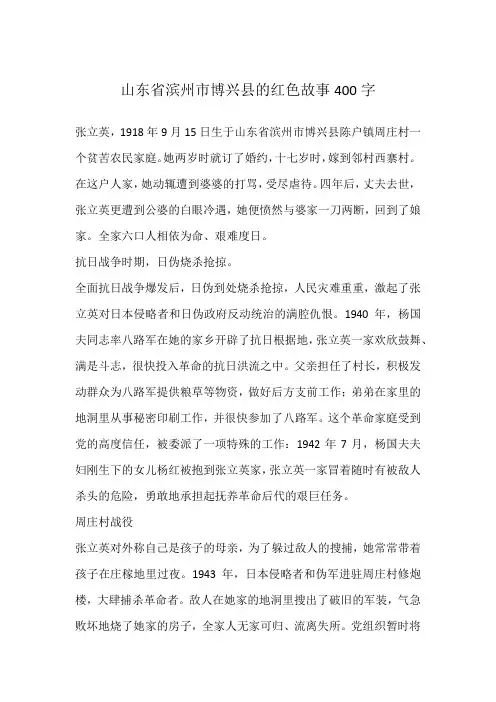
山东省滨州市博兴县的红色故事400字张立英,1918年9月15日生于山东省滨州市博兴县陈户镇周庄村一个贫苦农民家庭。
她两岁时就订了婚约,十七岁时,嫁到邻村西寨村。
在这户人家,她动辄遭到婆婆的打骂,受尽虐待。
四年后,丈夫去世,张立英更遭到公婆的白眼冷遇,她便愤然与婆家一刀两断,回到了娘家。
全家六口人相依为命、艰难度日。
抗日战争时期,日伪烧杀抢掠。
全面抗日战争爆发后,日伪到处烧杀抢掠,人民灾难重重,激起了张立英对日本侵略者和日伪政府反动统治的满腔仇恨。
1940年,杨国夫同志率八路军在她的家乡开辟了抗日根据地,张立英一家欢欣鼓舞、满是斗志,很快投入革命的抗日洪流之中。
父亲担任了村长,积极发动群众为八路军提供粮草等物资,做好后方支前工作;弟弟在家里的地洞里从事秘密印刷工作,并很快参加了八路军。
这个革命家庭受到党的高度信任,被委派了一项特殊的工作:1942年7月,杨国夫夫妇刚生下的女儿杨红被抱到张立英家,张立英一家冒着随时有被敌人杀头的危险,勇敢地承担起抚养革命后代的艰巨任务。
周庄村战役张立英对外称自己是孩子的母亲,为了躲过敌人的搜捕,她常常带着孩子在庄稼地里过夜。
1943年,日本侵略者和伪军进驻周庄村修炮楼,大肆捕杀革命者。
敌人在她家的地洞里搜出了破旧的军装,气急败坏地烧了她家的房子,全家人无家可归、流离失所。
党组织暂时将她安置在闫坊乡马家村一个贫农家中。
她姑姑家是村上的大地主,姑父和汉奸刘子刚常来常往,相互勾结。
张立英爱憎分明,立场坚定地执行党的指示,暗中打听姑父和汉奸们的情况,及时提供给情报站。
1942年7月至1946年8月,在抚育杨红期间,张立英先后担任过村妇女主任、村生产主任,“万兴成”纺织联社理事成员和分社经理等职。
1949年春,她光荣参加了在北京召开的中国妇女第一次全国代表大会,受到毛泽东、刘少奇、朱德、蔡畅、邓颖超等党和国家领导人的亲切接见。
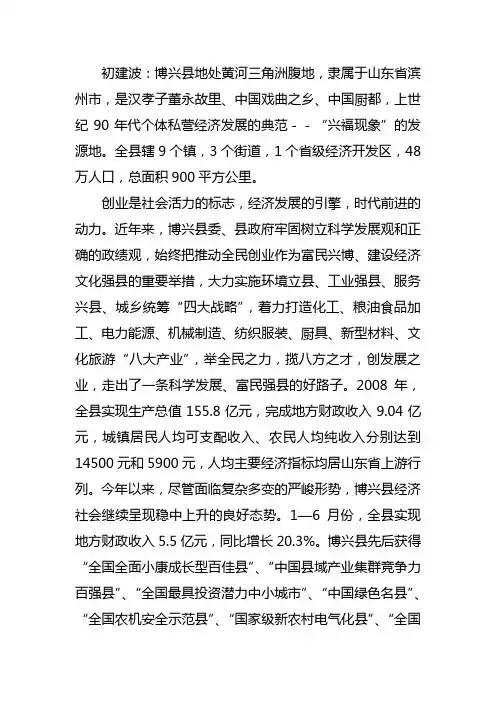
初建波:博兴县地处黄河三角洲腹地,隶属于山东省滨州市,是汉孝子董永故里、中国戏曲之乡、中国厨都,上世纪90年代个体私营经济发展的典范--“兴福现象”的发源地。
全县辖9个镇,3个街道,1个省级经济开发区,48万人口,总面积900平方公里。
创业是社会活力的标志,经济发展的引擎,时代前进的动力。
近年来,博兴县委、县政府牢固树立科学发展观和正确的政绩观,始终把推动全民创业作为富民兴博、建设经济文化强县的重要举措,大力实施环境立县、工业强县、服务兴县、城乡统筹“四大战略”,着力打造化工、粮油食品加工、电力能源、机械制造、纺织服装、厨具、新型材料、文化旅游“八大产业”,举全民之力,揽八方之才,创发展之业,走出了一条科学发展、富民强县的好路子。
2008年,全县实现生产总值155.8亿元,完成地方财政收入9.04亿元,城镇居民人均可支配收入、农民人均纯收入分别达到14500元和5900元,人均主要经济指标均居山东省上游行列。
今年以来,尽管面临复杂多变的严峻形势,博兴县经济社会继续呈现稳中上升的良好态势。
1—6月份,全县实现地方财政收入5.5亿元,同比增长20.3%。
博兴县先后获得“全国全面小康成长型百佳县”、“中国县域产业集群竞争力百强县”、“全国最具投资潜力中小城市”、“中国绿色名县”、“全国农机安全示范县”、“国家级新农村电气化县”、“全国现代渔业生产项目示范县”和“省级文明县”、“平安山东建设先进县”等荣誉称号。
我们开展全民创业工作的主要做法是:一、解放思想,提升全民创业认识实施全民创业工程,关键是转变创业观念,发扬创业精神。
开展全民创业,必须破除和改变一切阻碍和制约创业的思想观念。
近年来,博兴县相继开展了一系列解放思想主题活动,教育干部群众进一步解放思想,转变固步自封,胸无大志,小进则安,小富即满的小农意识;克服慵懒无为,但求无过,瞻前顾后,不敢想、不敢闯、不敢干的保守思想;改变只唯书、只唯上,不唯实,只想做官、不愿谋事的官本位思想;改变因循守旧,教条僵化,按部就班、一成不变的僵化观念。
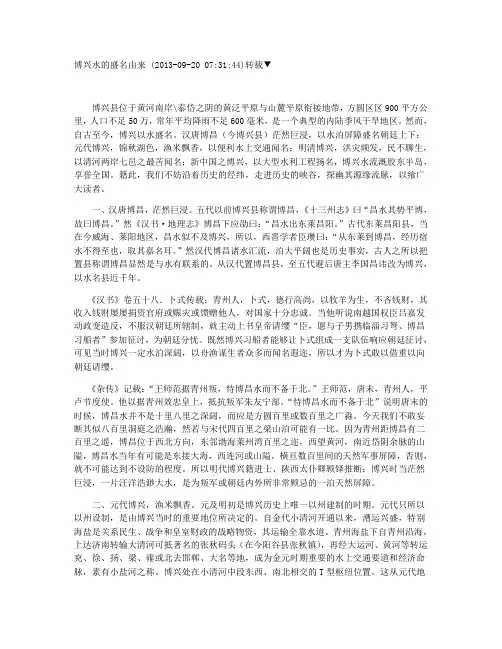
博兴水的盛名由来 (2013-09-20 07:31:44)转载▼博兴县位于黄河南岸\泰岱之阴的黄泛平原与山麓平原衔接地带,方圆区区900平方公里,人口不足50万,常年平均降雨不足600毫米,是一个典型的内陆季风干旱地区。
然而,自古至今,博兴以水盛名。
汉唐博昌(今博兴县)茫然巨浸,以水泊屏障盛名朝廷上下;元代博兴,锦秋湖色,渔米飘香,以便利水上交通闻名;明清博兴,洪灾频发,民不聊生,以清河两岸七邑之最苦闻名;新中国之博兴,以大型水利工程扬名,博兴水流溉胶东半岛,享誉全国。
籍此,我们不妨沿着历史的经纬,走进历史的峡谷,探幽其源缘流脉,以飨广大读者。
一、汉唐博昌,茫然巨浸。
五代以前博兴县称谓博昌,《十三州志》曰“昌水其势平博,故曰博昌。
”然《汉书·地理志》博昌下应劭曰:“昌水出东莱昌阳。
”古代东莱昌阳县,当在今威海、莱阳地区,昌水似不及博兴,所以,西晋学者臣瓒曰:“从东莱到博昌,经历宿水不得至也,取其嘉名耳。
”然汉代博昌诸水汇流,泊大平阔也是历史事实,古人之所以把置县称谓博昌显然是与水有联系的。
从汉代置博昌县,至五代避后唐主李国昌讳改为博兴,以水名县近千年。
《汉书》卷五十八.卜式传载:青州人,卜式,德行高尚,以牧羊为生,不吝钱财,其收入钱财屡屡捐资官府或赈灾或馈赠他人,对国家十分忠诚。
当他听说南越国权臣吕嘉发动政变造反,不服汉朝廷所辖制,就主动上书皇帝请缨“臣,愿与子男携临淄习弩、博昌习船者”参加征讨,为朝廷分忧。
既然博兴习船者能够让卜式组成一支队伍响应朝廷征讨,可见当时博兴一定水泊深阔,以舟渔谋生者众多而闻名遐迩,所以才为卜式敢以借重以向朝廷请缨。
《杂传》记载:“王师范据青州叛,恃博昌水而不备于北。
”王师范,唐末,青州人,平卢节度使。
他以据青州效忠皇上,抵抗叛军朱友宁部。
“恃博昌水而不备于北”说明唐末的时候,博昌水并不是十里八里之深阔,而应是方圆百里或数百里之广淼。
今天我们不敢妄断其似八百里洞庭之浩瀚,然若与宋代四百里之梁山泊可能有一比。
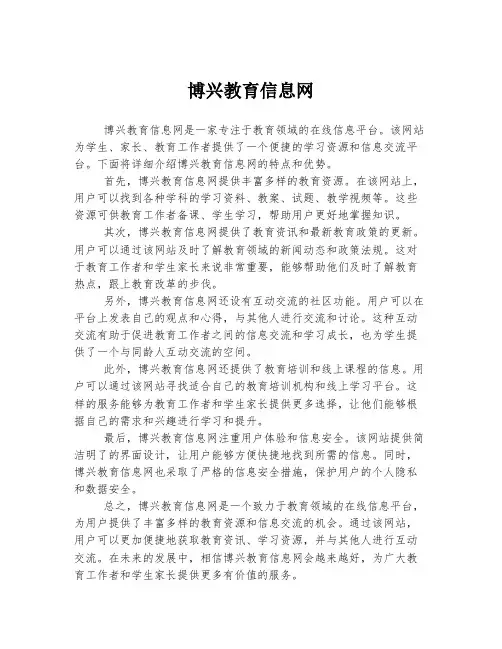
博兴教育信息网博兴教育信息网是一家专注于教育领域的在线信息平台。
该网站为学生、家长、教育工作者提供了一个便捷的学习资源和信息交流平台。
下面将详细介绍博兴教育信息网的特点和优势。
首先,博兴教育信息网提供丰富多样的教育资源。
在该网站上,用户可以找到各种学科的学习资料、教案、试题、教学视频等。
这些资源可供教育工作者备课、学生学习,帮助用户更好地掌握知识。
其次,博兴教育信息网提供了教育资讯和最新教育政策的更新。
用户可以通过该网站及时了解教育领域的新闻动态和政策法规。
这对于教育工作者和学生家长来说非常重要,能够帮助他们及时了解教育热点,跟上教育改革的步伐。
另外,博兴教育信息网还设有互动交流的社区功能。
用户可以在平台上发表自己的观点和心得,与其他人进行交流和讨论。
这种互动交流有助于促进教育工作者之间的信息交流和学习成长,也为学生提供了一个与同龄人互动交流的空间。
此外,博兴教育信息网还提供了教育培训和线上课程的信息。
用户可以通过该网站寻找适合自己的教育培训机构和线上学习平台。
这样的服务能够为教育工作者和学生家长提供更多选择,让他们能够根据自己的需求和兴趣进行学习和提升。
最后,博兴教育信息网注重用户体验和信息安全。
该网站提供简洁明了的界面设计,让用户能够方便快捷地找到所需的信息。
同时,博兴教育信息网也采取了严格的信息安全措施,保护用户的个人隐私和数据安全。
总之,博兴教育信息网是一个致力于教育领域的在线信息平台,为用户提供了丰富多样的教育资源和信息交流的机会。
通过该网站,用户可以更加便捷地获取教育资讯、学习资源,并与其他人进行互动交流。
在未来的发展中,相信博兴教育信息网会越来越好,为广大教育工作者和学生家长提供更多有价值的服务。
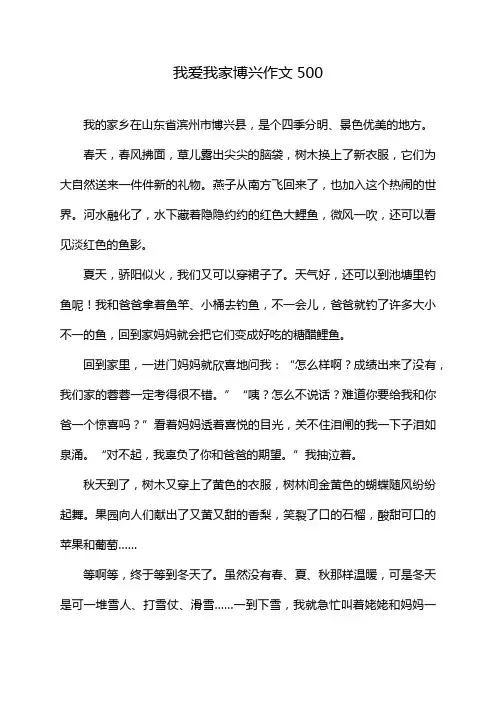
我爱我家博兴作文500
我的家乡在山东省滨州市博兴县,是个四季分明、景色优美的地方。
春天,春风拂面,草儿露出尖尖的脑袋,树木换上了新衣服,它们为大自然送来一件件新的礼物。
燕子从南方飞回来了,也加入这个热闹的世界。
河水融化了,水下藏着隐隐约约的红色大鲤鱼,微风一吹,还可以看见淡红色的鱼影。
夏天,骄阳似火,我们又可以穿裙子了。
天气好,还可以到池塘里钓鱼呢!我和爸爸拿着鱼竿、小桶去钓鱼,不一会儿,爸爸就钓了许多大小不一的鱼,回到家妈妈就会把它们变成好吃的糖醋鲤鱼。
回到家里,一进门妈妈就欣喜地问我:“怎么样啊?成绩出来了没有,我们家的蓉蓉一定考得很不错。
”“咦?怎么不说话?难道你要给我和你爸一个惊喜吗?”看着妈妈透着喜悦的目光,关不住泪闸的我一下子泪如泉涌。
“对不起,我辜负了你和爸爸的期望。
”我抽泣着。
秋天到了,树木又穿上了黄色的衣服,树林间金黄色的蝴蝶随风纷纷起舞。
果园向人们献出了又黄又甜的香梨,笑裂了口的石榴,酸甜可口的苹果和葡萄……
等啊等,终于等到冬天了。
虽然没有春、夏、秋那样温暖,可是冬天是可一堆雪人、打雪仗、滑雪……一到下雪,我就急忙叫着姥姥和妈妈一
起堆雪人。
我拿一个胡萝卜和一顶小帽子把雪人打扮得栩栩如生,这个过程简单又快乐,我们堆的雪人因为有一个长长的`鼻子,所以叫“长鼻子”。
我爱我美丽的家乡,也爱家乡的一年四季。

博兴是我出生成长的地方,在这个小小的地方有我的欢乐和成长。
我的家乡只是山东省滨州市的一个小县城。
她北临滨州,东靠东营,南挨淄博,就在这三个城市交汇处,在地图上只是一条小小的缝。
她既不依山也不傍水,也没有一山一水一圣人的光环,而且还相距他们很远。
只是和其他千千万万个默默无闻普通的小县城一样。
可我依然热爱着她。
我爱春天生机勃勃的家乡。
在乡下,每当那荠菜开出柔弱的,白白的花,我就知道春天马上要来了。
当树上的榆钱成串的时候,当茅草里的古迪探出头来的时候,当垂柳柳条腰肢开始柔软的时候,当雪白的杏花,粉色的桃花开满枝头的时候,我就知道县城里的连翘和迎春花要成团,樱花就要花团锦秀了。
闭上眼深深地吸一口气,也能感受到处处的生机勃勃。
我爱夏天成长中的家乡。
到处是大片大作文片的绿,深绿地毯的麦苗,浅绿色的足球场,淡绿色的白杨,翠绿色的冬青……在地毯似的草丛里抓几只蚂蚱,在蓝色的河水中快乐地游几次泳,暑假就“嗖”的过去了。
我爱秋天多彩的家乡。
红的枫树,紫的葡萄,红的苹果,白云般的棉花,金黄的树叶一夜铺满地,明晃晃的玉米铺满路……空气中飘着水果的清香,庄稼成熟的的味道,秋风袭来使人精神一振。
我爱冬天热闹的家乡。
过大年,放寒假都是在冬天哦。
家家户户挂灯笼,备年货,走亲访友,你来我往,人人笑逐颜开。
而我们孩子则三五成群,追逐打闹,难得的没有大人的呵斥,空气中飘着饭菜和淡淡的火药味。
深深地吸一口,好温馨的味道。
家乡,我说不上她的具体外观,留在记忆中的是我那浓于血水的乡恋。
不管时光如何变迁,你如何变化,我都深深爱着你,我的家乡博兴!1。
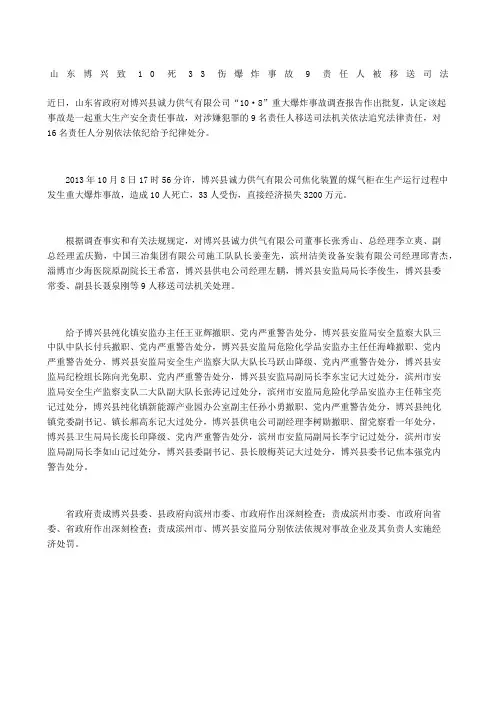
山东博兴致10死33伤爆炸事故9责任人被移送司法近日,山东省政府对博兴县诚力供气有限公司“10·8”重大爆炸事故调查报告作出批复,认定该起事故是一起重大生产安全责任事故,对涉嫌犯罪的9名责任人移送司法机关依法追究法律责任,对16名责任人分别依法依纪给予纪律处分。
2013年10月8日17时56分许,博兴县诚力供气有限公司焦化装置的煤气柜在生产运行过程中发生重大爆炸事故,造成10人死亡,33人受伤,直接经济损失3200万元。
根据调查事实和有关法规规定,对博兴县诚力供气有限公司董事长张秀山、总经理李立爽、副总经理孟庆勤,中国三冶集团有限公司施工队队长姜奎先,滨州洁美设备安装有限公司经理邱青杰,淄博市少海医院原副院长王希富,博兴县供电公司经理左鹏,博兴县安监局局长李俊生,博兴县委常委、副县长聂泉刚等9人移送司法机关处理。
给予博兴县纯化镇安监办主任王亚辉撤职、党内严重警告处分,博兴县安监局安全监察大队三中队中队长付兵撤职、党内严重警告处分,博兴县安监局危险化学品安监办主任任海峰撤职、党内严重警告处分,博兴县安监局安全生产监察大队大队长马跃山降级、党内严重警告处分,博兴县安监局纪检组长陈向光免职、党内严重警告处分,博兴县安监局副局长李东宝记大过处分,滨州市安监局安全生产监察支队二大队副大队长张涛记过处分,滨州市安监局危险化学品安监办主任韩宝亮记过处分,博兴县纯化镇新能源产业园办公室副主任孙小勇撤职、党内严重警告处分,博兴县纯化镇党委副书记、镇长郝高东记大过处分,博兴县供电公司副经理李树勋撤职、留党察看一年处分,博兴县卫生局局长庞长印降级、党内严重警告处分,滨州市安监局副局长李宁记过处分,滨州市安监局副局长李如山记过处分,博兴县委副书记、县长殷梅英记大过处分,博兴县委书记焦本强党内警告处分。
省政府责成博兴县委、县政府向滨州市委、市政府作出深刻检查;责成滨州市委、市政府向省委、省政府作出深刻检查;责成滨州市、博兴县安监局分别依法依规对事故企业及其负责人实施经济处罚。
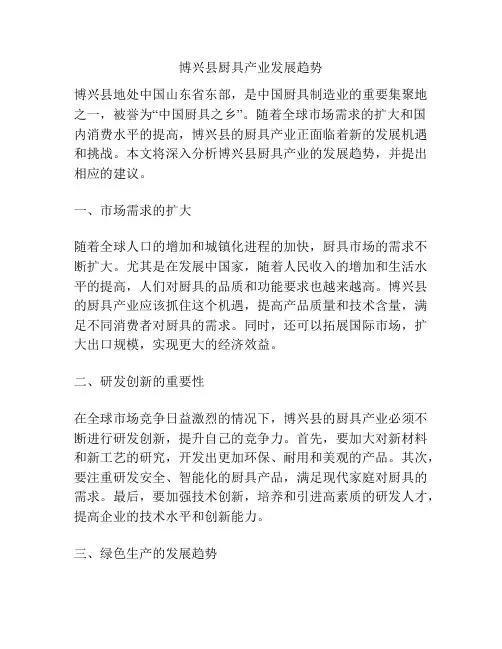
博兴县厨具产业发展趋势博兴县地处中国山东省东部,是中国厨具制造业的重要集聚地之一,被誉为“中国厨具之乡”。
随着全球市场需求的扩大和国内消费水平的提高,博兴县的厨具产业正面临着新的发展机遇和挑战。
本文将深入分析博兴县厨具产业的发展趋势,并提出相应的建议。
一、市场需求的扩大随着全球人口的增加和城镇化进程的加快,厨具市场的需求不断扩大。
尤其是在发展中国家,随着人民收入的增加和生活水平的提高,人们对厨具的品质和功能要求也越来越高。
博兴县的厨具产业应该抓住这个机遇,提高产品质量和技术含量,满足不同消费者对厨具的需求。
同时,还可以拓展国际市场,扩大出口规模,实现更大的经济效益。
二、研发创新的重要性在全球市场竞争日益激烈的情况下,博兴县的厨具产业必须不断进行研发创新,提升自己的竞争力。
首先,要加大对新材料和新工艺的研究,开发出更加环保、耐用和美观的产品。
其次,要注重研发安全、智能化的厨具产品,满足现代家庭对厨具的需求。
最后,要加强技术创新,培养和引进高素质的研发人才,提高企业的技术水平和创新能力。
三、绿色生产的发展趋势随着全球环保意识的增强,绿色生产已经成为一个全球共识。
博兴县的厨具产业也应该跟随这一趋势,加强环保管理,减少对环境的污染。
首先,要引进和推广绿色生产技术,提高能源利用效率,减少废弃物排放。
其次,要加强企业间的合作,共同开展环保研究和项目,促进绿色供应链的建立。
最后,要加强对员工的环保培训,提高他们的环保意识和素质。
四、品牌建设的迫切性在全球市场竞争中,品牌已经成为企业竞争的核心要素之一。
博兴县的厨具产业应该注重品牌建设,提高产品的知名度和美誉度。
首先,要加大对产品品质的把控,确保产品的质量和性能达到国际水平。
其次,要注重市场营销,加强对产品的宣传和推广,提高产品的知名度和认可度。
最后,要加大对品牌文化的培养和宣传,打造有特色的品牌形象,并与其他优势企业合作,共同推进品牌建设。
五、国际竞争力的提升随着中国制造业的快速发展和全球市场的扩大,博兴县的厨具产业面临着日益激烈的国际竞争。
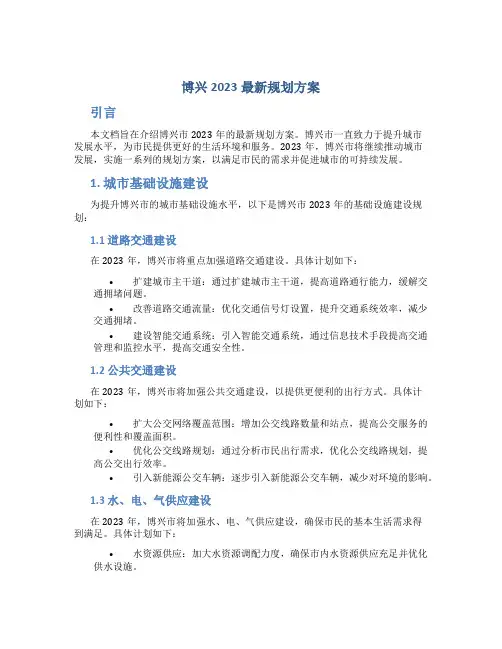
博兴2023最新规划方案引言本文档旨在介绍博兴市2023年的最新规划方案。
博兴市一直致力于提升城市发展水平,为市民提供更好的生活环境和服务。
2023年,博兴市将继续推动城市发展,实施一系列的规划方案,以满足市民的需求并促进城市的可持续发展。
1. 城市基础设施建设为提升博兴市的城市基础设施水平,以下是博兴市2023年的基础设施建设规划:1.1 道路交通建设在2023年,博兴市将重点加强道路交通建设。
具体计划如下:•扩建城市主干道:通过扩建城市主干道,提高道路通行能力,缓解交通拥堵问题。
•改善道路交通流量:优化交通信号灯设置,提升交通系统效率,减少交通拥堵。
•建设智能交通系统:引入智能交通系统,通过信息技术手段提高交通管理和监控水平,提高交通安全性。
1.2 公共交通建设在2023年,博兴市将加强公共交通建设,以提供更便利的出行方式。
具体计划如下:•扩大公交网络覆盖范围:增加公交线路数量和站点,提高公交服务的便利性和覆盖面积。
•优化公交线路规划:通过分析市民出行需求,优化公交线路规划,提高公交出行效率。
•引入新能源公交车辆:逐步引入新能源公交车辆,减少对环境的影响。
1.3 水、电、气供应建设在2023年,博兴市将加强水、电、气供应建设,确保市民的基本生活需求得到满足。
具体计划如下:•水资源供应:加大水资源调配力度,确保市内水资源供应充足并优化供水设施。
•电力供应:提升电力供应能力,加强电网建设和设备维护,确保电力稳定供应。
•天然气供应:扩大天然气供应范围,优化供气设施,提高供气质量和可靠性。
2. 城市环境保护博兴市将继续加强城市环境保护工作,并致力于提高市民的生活质量。
以下是博兴市2023年的环境保护规划:2.1 空气质量改善博兴市将采取一系列措施改善空气质量,减少大气污染。
具体计划如下:•减少工业污染物排放:通过加强对工业企业的监管和管理,减少工业污染物的排放。
•推广清洁能源使用:鼓励市民使用清洁能源,减少燃煤污染对空气质量的影响。
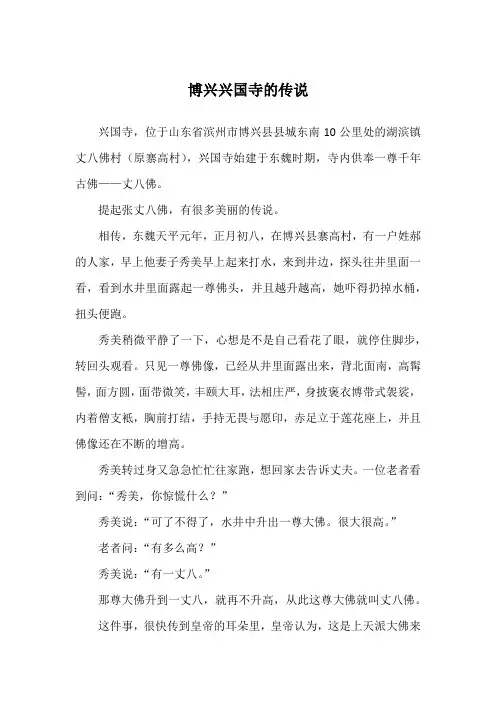
博兴兴国寺的传说兴国寺,位于山东省滨州市博兴县县城东南10公里处的湖滨镇丈八佛村(原寨高村),兴国寺始建于东魏时期,寺内供奉一尊千年古佛——丈八佛。
提起张丈八佛,有很多美丽的传说。
相传,东魏天平元年,正月初八,在博兴县寨高村,有一户姓郝的人家,早上他妻子秀美早上起来打水,来到井边,探头往井里面一看,看到水井里面露起一尊佛头,并且越升越高,她吓得扔掉水桶,扭头便跑。
秀美稍微平静了一下,心想是不是自己看花了眼,就停住脚步,转回头观看。
只见一尊佛像,已经从井里面露出来,背北面南,高髯髻,面方圆,面带微笑,丰颐大耳,法相庄严,身披褒衣博带式袈裟,内着僧支袛,胸前打结,手持无畏与愿印,赤足立于莲花座上,并且佛像还在不断的增高。
秀美转过身又急急忙忙往家跑,想回家去告诉丈夫。
一位老者看到问:“秀美,你惊慌什么?”秀美说:“可了不得了,水井中升出一尊大佛。
很大很高。
”老者问:“有多么高?”秀美说:“有一丈八。
”那尊大佛升到一丈八,就再不升高,从此这尊大佛就叫丈八佛。
这件事,很快传到皇帝的耳朵里,皇帝认为,这是上天派大佛来保佑国家兴亡,人民安康的,他就派遣能工巧匠,在大佛处建造了一座寺院,皇帝亲自命名为“兴国寺。
”兴国寺完工以后,来烧香拜佛的善男信女络绎不绝,有的求财,有的求寿,有的免灾,有的求子,他们各有各的心愿,都在虔诚的祷告。
说来也奇怪,丈八佛有求必应。
因为是正月初八发现丈八佛,四月初八兴国寺竣工,因此,人们自发的赶到兴国寺拜佛,这两天就逐渐形成了庙会,一直沿袭至今。
再说这户姓郝的人家,一直住在兴国寺一边。
从兴国寺完成那天开始,他们家世世代代,每天都要到兴国寺里去,参拜丈八佛,清扫卫生。
到了宋代,姓郝的主人叫郝仁,妻子叫心美。
他每天做的第一件事也是到兴国寺参拜大佛,清扫卫生。
郝仁夫妻为人仗义,经常接济村里的穷人,人们对他们都交口赞扬。
这一年冬天,夜里下起了大雪,郝仁早上起来扫完自家的院子,然后他拿着扫帚去打扫兴国寺里面的积雪。

我家乡博兴美丽的东永乡,两边宽阔的道路是一座高楼。
我们有一个文化广场在拳击,体育广场,人民公园等。
我想谈一下体育广场吧,它靠近昌发牛,晚上,有很多奶奶练太极,有一个游泳池,五环以上,走几步到一个大健身房,其中一些玩幻灯片,一些在秋千,和一些在小单板桥。
我的小硬木桥给了我最深的印象,记得最后一次,我的父亲和母亲去那里,我父亲让我走,我不想去,但看着别人这么容易,我决定试试,但是,当我走到木桥,木桥摇晃,我妈妈在接下来命令我,我第四次走了一脚,看了一下木桥,可是为了我母亲鼓励我,我现在不敢走!我决定去下一次结束。
拳击真的很漂亮!我爱我的家乡。
PROJECT DESIGN DOCUMENT FORM (CDM PDD) - Version 03.1. CDM – Executive Board
page 1
CLEAN DEVELOPMENT MECHANISM PROJECT DESIGN DOCUMENT FORM (CDM-PDD) Version 03 - in effect as of: 28 July 2006
CONTENTS A. General description of project activity B. Application of a baseline and monitoring methodology C. Duration of the project activity / crediting period D. Environmental impacts E. Stakeholders’ comments Annexes Annex 1: Contact information on participants in the project activity Annex 2: Information regarding public funding Annex 3: Baseline information Annex 4: Monitoring plan PROJECT DESIGN DOCUMENT FORM (CDM PDD) - Version 03.1. CDM – Executive Board
page 2
SECTION A. General description of project activity A.1 Title of the project activity: >>
6MW Biomass cogeneration project, in Boxing County, Shandong Province, P.R.China PDD version 2.0 Date: October 10 2007
A.2. Description of the project activity: >>
The proposed project is a newly-built generation project with straw fired fuel, which is located in the area with abundant cotton straw resource. The installed capacity of this project is 6MW and the annual straws’ consumption is about 78,426 t, and it is expected to deliver annually 28.876 GWh electricity to Northern China Power Grid (NCPG) of China and 936.4TJ to the heat consumers.
When the proposed project is put into operation, the GHG emission reductions are from two components. Firstly, it will substitute some electricity generation of NCPG dominated by fossil fuel fired power plants. Secondly, it will use straw more efficiently, which will reduce CH4 emissions because the biomass is
dumped or left to decay or burned in an uncontrolled manner in the absence of the proposed project. The estimated annual GHG emission reductions are 119,257 tCO2e.
The proposed project makes good use of the renewable straws as fuels for generation; it will produce positive economic and environmental benefits and contributes to the local sustainable development through following aspects:
z By utilizing the straws for generation, to improve local environment ,and to be consistent with China’s national energy policy and industry policy;
z To reduce a great deal of straws dumped or left to decay or burned in an uncontrolled manner and related air pollution , and thus will prevent the negative influences of smog pervasion on road and airport transportation due to straws burnt in the open air;
z To increase the supply of local power generation, and will alleviate power shortage in the local areas, and thus will reduce the fossil fuel consumption;
z To increase the income of local residents because the straws as by-product of crop can be sold; to create new job opportunities for the local people and new income sources because of the activities of straws collection, storage and transportation;
A.3. Project participants: >> Name of Party involved (*) ((host) indicates a host Party)
Private and/or public entity(ies) project participants (*) (as applicable)
Kindly indicate if the Party involved wishes to be considered as project participant (Yes/No) PROJECT DESIGN DOCUMENT FORM (CDM PDD) - Version 03.1. CDM – Executive Board
page 3
P.R. China CLP Huanyu (Shandong) Biomass Heat & Power Co., Ltd. Yes
For detailed information, please refer to Annex I. A.4. Technical description of the project activity: A.4.1. Location of the project activity: >>
A.4.1.1. Host Party(ies):
>>
P.R. China
A.4.1.2. Region/State/Province etc.: >>
Shandong Province
A.4.1.3. City/Town/Community etc: >> Binzhou City, Boxing County, Zhaihao Village
A.4.1.4. Detail of physical location, including information allowing the unique identification of this project activity (maximum one page): >>
The proposed project is located in Zhaihao Village in the southeast of Boxing County, northeast of Shandong Province. It is near to the west of Haihe Road and south of Taihang Road, and 2.5km away from the county centre. Geographical location of the project is shown in figure 1.
The proposed project is located north latitude of 37°32′34′′-37°32′40′′ east longitude of 118º47′21′′-118º47′32′′.